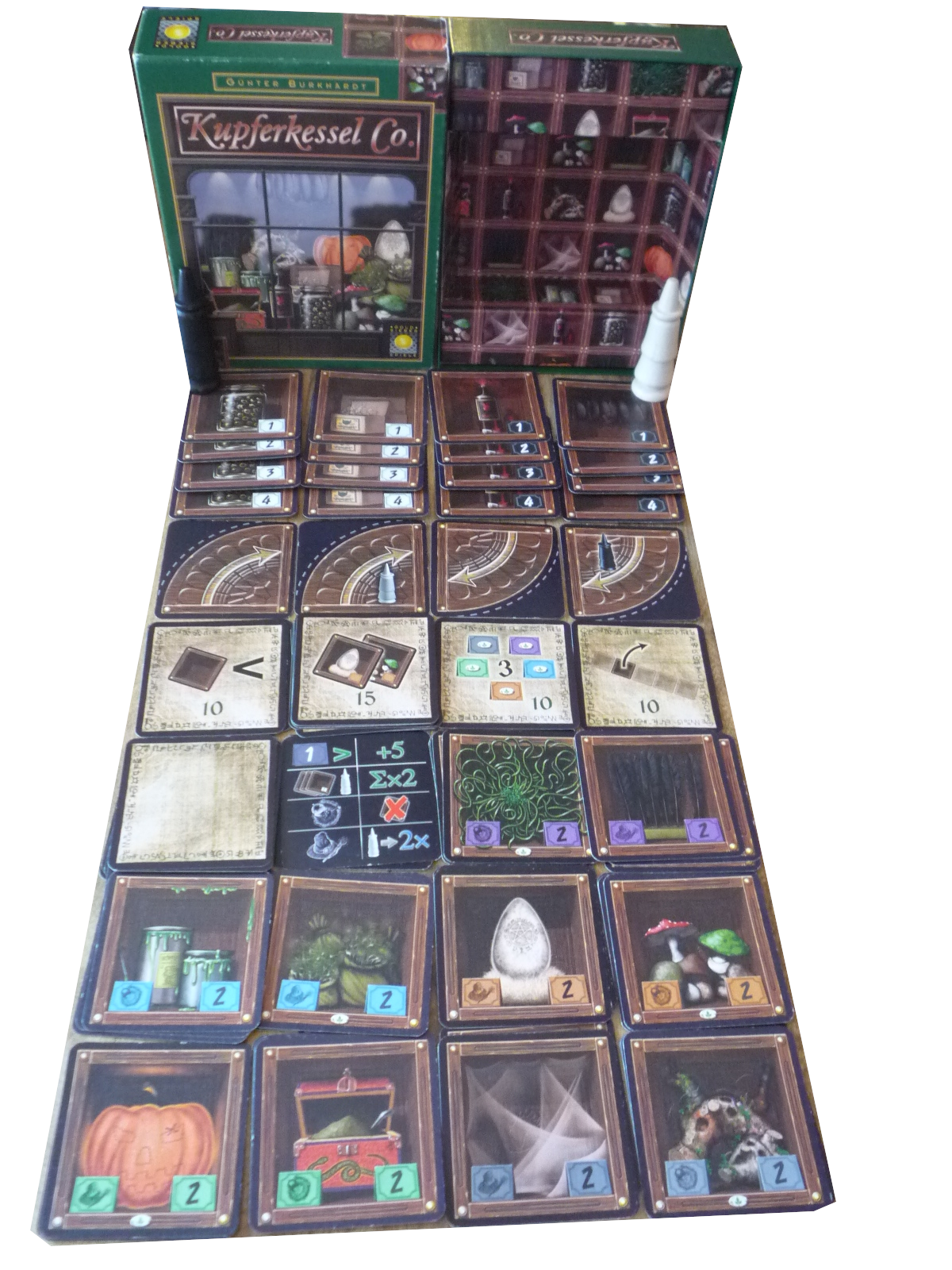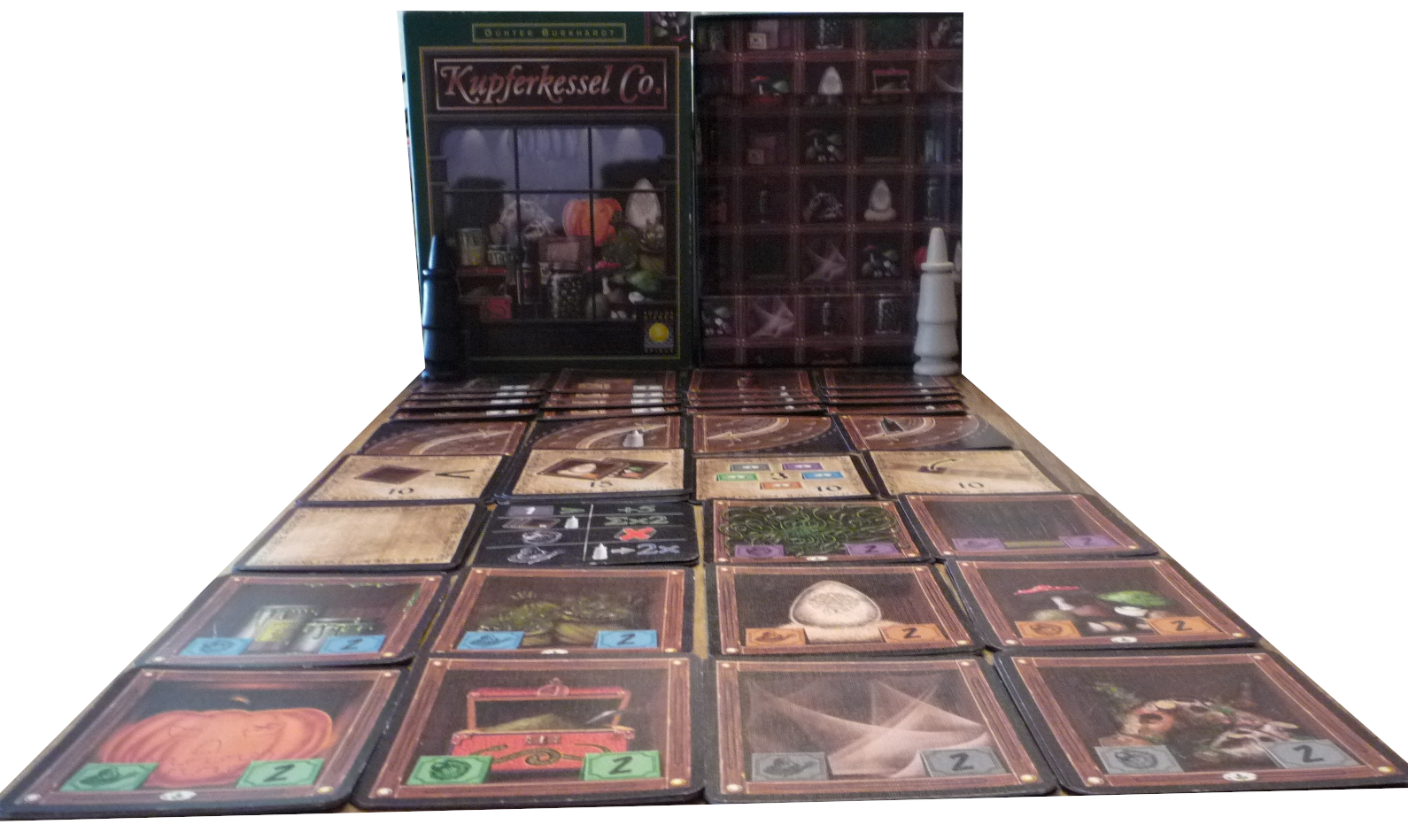Strategy: Low; Theme: Medium; Tactics: High; Evaluation: Medium; Personal Rating: 5
Lutz Stepponat; Hans-im-Glück/Rio Grande; 2006; 2-6 [Buy it at Amazon]

|
LLHH5 (Strategy: Low; Theme: Low; Tactics: High; Evaluation: High; Personal Rating: 5)
Scott Caputo; Bucephalus Games-2009; 2-5 [Buy it at Amazon]

|
Jacques Zeimet; Drei Magier Spiele GmbH; 2004; 2-6
LLML7 (Strategy: Low; Theme: Low; Tactics: Medium; Evaluation: Low; Personal Rating: 7)

|
MLLM5 (Strategy: Medium; Theme: Low; Tactics: Low; Evaluation: Medium; Personal Rating: 5)
Spartaco Albertarelli; Editrice Giochi-1995/Ystari/Cocktail-2008; 2-10; 8+
Strategy: Low; Theme: Medium; Tactics: Medium; Evaluation: Low; Personal Rating: 6
Klaus Teuber; Kosmos; 2006; 3-4
Günter Cornett; Bambus; 2001; 3-4
Uwe Rosenberg; Hanno Girke; Lookout Games; 2006; 2
Strategy: Medium; Theme: Low; Tactics: Medium; Evaluation: High; Personal Rating: 7
Strategy: High; Theme: Medium; Tactics: High; Evaluation: High; Personal Rating: 8
Michael Schacht; Goldsieber/Rio Grande; 2000; 3-5
The China re-issue preserves the feeling and gameplay of the original almost entirely intact while transporting it in space and time to the Warring States Period in Ancient Cathay. Of course this means a new board layout, but even this works quite similarly to the European version. There is even a France equivalent in the same color (Chu). What's innovative about the board is that it's double-sided and when playing with four or fewer, a number of the usual road connections are omitted. The only change with respect to the cards is that when drafting there are now four visible rather than three, which lessens either angst or frustration, depending on point of view. Finally, and most significantly, there is no longer a scoring round at the midpoint of play, thus reducing the importance of the houses by almost a factor of two. It's still necessary to participate in houses to win, however, if for no other reason than there are not enough emessary pieces available to make a strategy based solely on them feasible. But houses and roads can be made to count more if the new, optional fortifications rules are employed. Six neutral fort pieces are provided. One of them can be placed along with one's house, which costs an extra action and card. The benefit is that whenever this house participates in majority or road scoring, the score achieved is doubled. Since these are so valuable, it behooves each player to use his share of these neutral items. Letting someone use more than his share may well be permitting an easy victory. For this reason perhaps some later rules revision may assign these to players for their sole usage. The new setting is a clear indicator that theme is not a major feature here, but with no Templar-equivalents in China it's even more difficult to guess who the players might represent. The production is quite nice, featuring attractive yellowish shades for most of the countries and mushroom looking pieces for the emissaries. That the boards show how many players they accept not by printing the number but by showing the number of figures in the corner is cool. There are round tokens used to indicate when a region has been scored (so that players have some idea of how each player is doing as play goes along). In the department of things that are slightly annoying but in the end don't matter, these tokens seem exactly the right size to place on the circles that indicate each country's capital. But doing so is troublesome because then it's necessary to pick up the advisors and put them back down on it as well as the fact that the disks are not really large enough to securely hold these mushrooms. Perhaps the original board is slightly more artistically drawn, but overall this is no less a product than the original and the choice of which to get can only come down to rather minor and personal factors. At the time of this writing there are also three add-ons available: the two-player variant, China – Das Duell, as well as the expansions China Erweiterung and China – Grenzstreitigkeiten.
Strategy: High; Theme: Medium; Tactics: High; Evaluation: High; Personal Rating: 8
Michael Schacht; Abacus/Ueberplay; 2005; 3-5 [Buy it at Amazon]
Strategy: High; Theme: Medium; Tactics: High; Evaluation: Medium; Personal Rating: 6
Michael Schacht; Spiele aus Timbuktu;
Strategy: High; Theme: Medium; Tactics: High; Evaluation: Medium; Personal Rating: 6
Michael Schacht; Spiele aus Timbuktu;
Michael Schacht; Spiele aus Timbuktu;

|
Reiner Knizia; Kosmos-2007; 2-4; 30
Strategy: Medium; Theme: Low; Tactics: Medium; Evaluation: Medium; Personal Rating: 6 [Amazon.com]

|
Strategy: Medium; Theme: Low; Tactics: Medium; Evaluation: High; Personal Rating: 7
Richard Breese; 2007; R&D Games; 2-4 [Buy it at Amazon]
Personal rating: 6
| Hand | VP |
| Sequence of 3 | 1 |
| Triplet | 2 |
| J, Q, K | 3 |
| J and two diamond 7s | 4 |
| Q and two club 8s | 4 |
| K and two heart 9s | 4 |
| A heart, 2 club, 3 diamond (Khanhoo) | 5 |
- The hand ends on the turn the last deck card is drawn, or immediately whenever a player can show that all their hand cards belong to sets.
- If there are more than two players and more than one wants to claim a discard, precedence goes to the elder hand (first player left of the discvarding player) that wants it.
- Claiming a discard means that the player melds the set to which it belongs.
- A player cannot change a melded set.
- When the hand ends, all players count points for sets whether held or melded.
Strategy: Medium; Theme: High; Tactics: Medium; Evaluation: Medium; Personal Rating: 7
Ludovic Vialla & Arnaud Urbon; Matagot; 2006; 2-5 [Buy it at Amazon]
Alan R. Moon
Strategy: Medium; Theme: Low; Tactics: Medium; Evaluation: Medium; Personal Rating: 5
Peer Sylvester; Histogame; 2007; 2-4
Strategy: Low; Theme: Low; Tactics: High; Evaluation: Medium; Personal Rating: 6
Steve Kingsbury; JKLM Games; 2005; 3-5
Strategy: High; Theme: Medium; Tactics: Medium; Evaluation: Low; Personal Rating: 6
Andrea Chiarvesio & Luca Iennaco; Mario Truant Verlag/Elfin Werks; 2007; 2-5 [Buy it at Amazon]
Strategy: Medium; Theme: Low; Tactics: High; Evaluation: Low

|
LHMM6 (Strategy: Low; Theme: High; Tactics: Medium; Evaluation: Medium; Personal Rating: 6)
Stefanie Rohner & Christian Wolf; HABA-1993; 2-4; 6+

|
Strategy: Medium; Theme: High; Tactics: High; Evaluation: Medium; Personal Rating: 6 Uwe Rosenberg; 1999 [Buy it at Amazon]
Uwe Rosenberg; Hans-im-Glück/Lookout; 1999; 3-5
Alan R. Moon
Strategy: Low; Theme: Low; Tactics: High; Evaluation: Medium
Alan R. Moon
MMMH6 (Strategy: Medium; Theme: Medium; Tactics: Medium; Evaluation: High; Personal Rating: 6)
Alessandro Saragosa (developed by Venice Connection); Clementoni; 2005; 2-5; 8+
Update: In 2008 Tilsit announced plans to re-publish this as Amsterdam.
Strategy: Medium; Theme: Medium; Tactics: High; Evaluation: Medium; Personal Rating: 6
Michael Schacht; 1999; Goldsieber; 2, 4 [variant]
|
|
MMMH7 (Strategy: Medium; Theme: Medium; Tactics: Medium; Evaluation: High; Personal Rating: 7)
Chislaine van den Bulk; Giuoco-2009; 2-4 [Shop]
Strategy: Medium; Theme: Low; Tactics: High; Evaluation: Medium; Personal Rating: 6
Stefan Dorra;
Personal Rating: 5
| See Recent Articles |
| Vote the Next Review |

|
LHMM6 (Strategy: Low; Theme: High; Tactics: Medium; Evaluation: Medium; Personal Rating: 6)
Adam Kaluza; Rebel.pl-2010/White Goblin-2010/Heidelberger Spieleverlag-2010; 1-5; 60 [Amazon.com]
LLHL4 (Strategy: Low; Theme: Low; Tactics: High; Evaluation: Low; Personal Rating: 4)
Karl-Heinz Schmiel; Moskito-1995; 2-5
 click for larger version
click for larger version
|
Two-player card game for children of collecting sets of colorful
magic items. These are laid out in a grid, the edges being
traveled by the player pawns. The cards are dual use so the
decision of which card to extract from a row pertains both to
what the player is collecting and what the next move will be.
A few cards feature special effects such as forcing a player to
discard their top card. Bonuses are given for large and complete
sets with penalties for odd lots. Interaction is limited and a
good memory helps, but the rules are simple, play elegant and
a good ability to look ahead definitely rewarded. Thus, it
works fairly well as a quick game even for adults if one wants
something not too serious. Inventor-supplied web variant makes
play possible for three with simple addition of another pawn.
One oddity, especially in this version, is that if a player
takes a card indicating a move of four and ends on a corner,
if other players can continually get in the way, he will always
simply hit the next corner, meaning he is unable to take any
points nor even escape from his situation. It's not quite clear
whether this is a bug or a feature. Title means "Copperpot Co.".
The inventor has since created a similar effort for up to five
called
Herr der Ziegen.
[variants]
[Holiday List 2002]
[Frequently Played]
Strategy: Low; Theme: Medium; Tactics: Medium; Evaluation: Medium; Personal Rating: 6 Günter Burkhardt; Goldsieber; 2001; 2 (3) |
 click for larger version
click for larger version
|
Michael Palm & Lukas Zach; Adlung-Spiele-2006; 3-10
Strategy: Medium; Theme: Medium; Tactics: Medium; Evaluation: Medium; Personal Rating: 5 Amazon